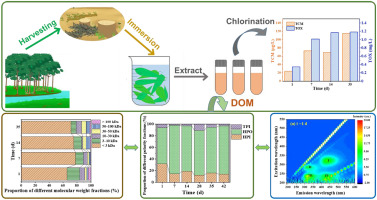当前位置:
X-MOL 学术
›
Chemosphere
›
论文详情
Our official English website, www.x-mol.net, welcomes your feedback! (Note: you will need to create a separate account there.)
Characteristics and disinfection byproducts formation potential of dissolved organic matter released from fast-growing Eucalyptus urophylla leaves.
Chemosphere ( IF 8.8 ) Pub Date : 2020-01-27 , DOI: 10.1016/j.chemosphere.2020.126017 Lu Liu 1 , Yankui Tang 2 , Weiwei Yang 3 , Wenlu Li 1 , Bo Fang 1 , Yaxuan Zhong 1 , Maozhong Yin 1 , Yuwei Chen 1 , Huiyi Yang 1
Chemosphere ( IF 8.8 ) Pub Date : 2020-01-27 , DOI: 10.1016/j.chemosphere.2020.126017 Lu Liu 1 , Yankui Tang 2 , Weiwei Yang 3 , Wenlu Li 1 , Bo Fang 1 , Yaxuan Zhong 1 , Maozhong Yin 1 , Yuwei Chen 1 , Huiyi Yang 1
Affiliation

|
Every year, the harvesting of Eucalyptus generates a large amount of abandoned Eucalyptus leaves (ELs), which may release dissolved organic matter (DOM) when immersed in water. If these substances are carried by surface runoff directly to the source of drinking water, some components in the DOM tend to form disinfection byproducts (DBPs) within the water-supply system, posing risk to human health. In this study, the characteristics of DOM released from leaves of Eucalyptus urophylla were studied and the potential of DBPs formation of the EL-released DOM during the chlorination process was investigated. The results showed that the EL-released DOM was mainly composed of small molecules and hydrophobic substances. Of the total EL-released DOM, the proportion with molecular weight less than 10 kDa accounted for over 80% and the hydrophobic substances took up over 62%. The DOM showed strong absorbance at UV254 and the fluorescence response corresponding to humic acid-like (HA-like) fractions, soluble microbial byproduct-like, aromatic protein and fulvic acid-like (FA-like) material, which have been considered to be related to the potential precursors of chlorinated DBPs. Non-targeted screening demonstrated the presence of phenolics, carbohydrates, and amino acids. The analysis of products generated in chlorination process revealed the formation of trichloromethane (TCM) and the total organic halogen (TOX). The present study fully confirms that the DOM released from Eucalyptus urophylla leaves has great potential for the generation of chlorinated DBPs.
中文翻译:

快速生长的尾叶桉树叶释放的溶解性有机物的特性和消毒副产物形成潜力。
每年,桉树的收获都会产生大量废弃的桉树叶子(ELs),当它们浸入水中时会释放出溶解的有机物(DOM)。如果这些物质通过地表径流直接带入饮用水源,则DOM中的某些成分往往会在供水系统内形成消毒副产物(DBP),对人体健康构成风险。在这项研究中,研究了尾叶桉叶释放的DOM的特性,并研究了氯化过程中EL释放DOM的DBP形成潜力。结果表明,EL释放的DOM主要由小分子和疏水性物质组成。在EL发布的全部DOM中,分子量小于10kDa的比例占80%以上,疏水性物质占62%以上。DOM在UV254处显示出强吸收性,并且荧光响应对应于腐殖酸样(HA样)级分,可溶性微生物副产物样,芳香族蛋白和黄腐酸样(FA样)材料,这些材料被认为是与氯化DBP的潜在前体有关。非靶向筛查表明存在酚类,碳水化合物和氨基酸。对氯化过程中生成的产物的分析表明,形成了三氯甲烷(TCM)和总有机卤素(TOX)。本研究充分证实了从尾叶桉叶中释放的DOM具有产生氯化DBP的巨大潜力。DOM在UV254处显示出强吸收性,并且荧光响应对应于腐殖酸样(HA样)级分,可溶性微生物副产物样,芳香族蛋白和黄腐酸样(FA样)材料,这些材料被认为是与氯化DBP的潜在前体有关。非靶向筛查表明存在酚类,碳水化合物和氨基酸。对氯化过程中生成的产物的分析表明,形成了三氯甲烷(TCM)和总有机卤素(TOX)。本研究充分证实了从尾叶桉叶中释放的DOM具有产生氯化DBP的巨大潜力。DOM在UV254处显示出强吸收性,并且荧光响应对应于腐殖酸样(HA样)级分,可溶性微生物副产物样,芳香族蛋白和黄腐酸样(FA样)材料,这些材料被认为是与氯化DBP的潜在前体有关。非靶向筛查表明存在酚类,碳水化合物和氨基酸。对氯化过程中生成的产物的分析表明,形成了三氯甲烷(TCM)和总有机卤素(TOX)。本研究充分证实了从尾叶桉叶中释放的DOM具有产生氯化DBP的巨大潜力。芳香蛋白和富里酸样(FA样)材料,它们被认为与氯化DBP的潜在前体有关。非靶向筛查表明存在酚类,碳水化合物和氨基酸。对氯化过程中生成的产物的分析表明,形成了三氯甲烷(TCM)和总有机卤素(TOX)。本研究充分证实了从尾叶桉叶中释放的DOM具有产生氯化DBP的巨大潜力。芳香蛋白和富里酸样(FA样)物质,它们被认为与氯化DBP的潜在前体有关。非靶向筛查表明存在酚类,碳水化合物和氨基酸。对氯化过程中生成的产物的分析表明,形成了三氯甲烷(TCM)和总有机卤素(TOX)。本研究充分证实了从尾叶桉叶中释放的DOM具有产生氯化DBP的巨大潜力。对氯化过程中生成的产物的分析表明,形成了三氯甲烷(TCM)和总有机卤素(TOX)。本研究充分证实了从尾叶桉叶中释放的DOM具有产生氯化DBP的巨大潜力。对氯化过程中生成的产物的分析表明,形成了三氯甲烷(TCM)和总有机卤素(TOX)。本研究充分证实了从尾叶桉叶中释放的DOM具有产生氯化DBP的巨大潜力。
更新日期:2020-01-27
中文翻译:

快速生长的尾叶桉树叶释放的溶解性有机物的特性和消毒副产物形成潜力。
每年,桉树的收获都会产生大量废弃的桉树叶子(ELs),当它们浸入水中时会释放出溶解的有机物(DOM)。如果这些物质通过地表径流直接带入饮用水源,则DOM中的某些成分往往会在供水系统内形成消毒副产物(DBP),对人体健康构成风险。在这项研究中,研究了尾叶桉叶释放的DOM的特性,并研究了氯化过程中EL释放DOM的DBP形成潜力。结果表明,EL释放的DOM主要由小分子和疏水性物质组成。在EL发布的全部DOM中,分子量小于10kDa的比例占80%以上,疏水性物质占62%以上。DOM在UV254处显示出强吸收性,并且荧光响应对应于腐殖酸样(HA样)级分,可溶性微生物副产物样,芳香族蛋白和黄腐酸样(FA样)材料,这些材料被认为是与氯化DBP的潜在前体有关。非靶向筛查表明存在酚类,碳水化合物和氨基酸。对氯化过程中生成的产物的分析表明,形成了三氯甲烷(TCM)和总有机卤素(TOX)。本研究充分证实了从尾叶桉叶中释放的DOM具有产生氯化DBP的巨大潜力。DOM在UV254处显示出强吸收性,并且荧光响应对应于腐殖酸样(HA样)级分,可溶性微生物副产物样,芳香族蛋白和黄腐酸样(FA样)材料,这些材料被认为是与氯化DBP的潜在前体有关。非靶向筛查表明存在酚类,碳水化合物和氨基酸。对氯化过程中生成的产物的分析表明,形成了三氯甲烷(TCM)和总有机卤素(TOX)。本研究充分证实了从尾叶桉叶中释放的DOM具有产生氯化DBP的巨大潜力。DOM在UV254处显示出强吸收性,并且荧光响应对应于腐殖酸样(HA样)级分,可溶性微生物副产物样,芳香族蛋白和黄腐酸样(FA样)材料,这些材料被认为是与氯化DBP的潜在前体有关。非靶向筛查表明存在酚类,碳水化合物和氨基酸。对氯化过程中生成的产物的分析表明,形成了三氯甲烷(TCM)和总有机卤素(TOX)。本研究充分证实了从尾叶桉叶中释放的DOM具有产生氯化DBP的巨大潜力。芳香蛋白和富里酸样(FA样)材料,它们被认为与氯化DBP的潜在前体有关。非靶向筛查表明存在酚类,碳水化合物和氨基酸。对氯化过程中生成的产物的分析表明,形成了三氯甲烷(TCM)和总有机卤素(TOX)。本研究充分证实了从尾叶桉叶中释放的DOM具有产生氯化DBP的巨大潜力。芳香蛋白和富里酸样(FA样)物质,它们被认为与氯化DBP的潜在前体有关。非靶向筛查表明存在酚类,碳水化合物和氨基酸。对氯化过程中生成的产物的分析表明,形成了三氯甲烷(TCM)和总有机卤素(TOX)。本研究充分证实了从尾叶桉叶中释放的DOM具有产生氯化DBP的巨大潜力。对氯化过程中生成的产物的分析表明,形成了三氯甲烷(TCM)和总有机卤素(TOX)。本研究充分证实了从尾叶桉叶中释放的DOM具有产生氯化DBP的巨大潜力。对氯化过程中生成的产物的分析表明,形成了三氯甲烷(TCM)和总有机卤素(TOX)。本研究充分证实了从尾叶桉叶中释放的DOM具有产生氯化DBP的巨大潜力。



























 京公网安备 11010802027423号
京公网安备 11010802027423号